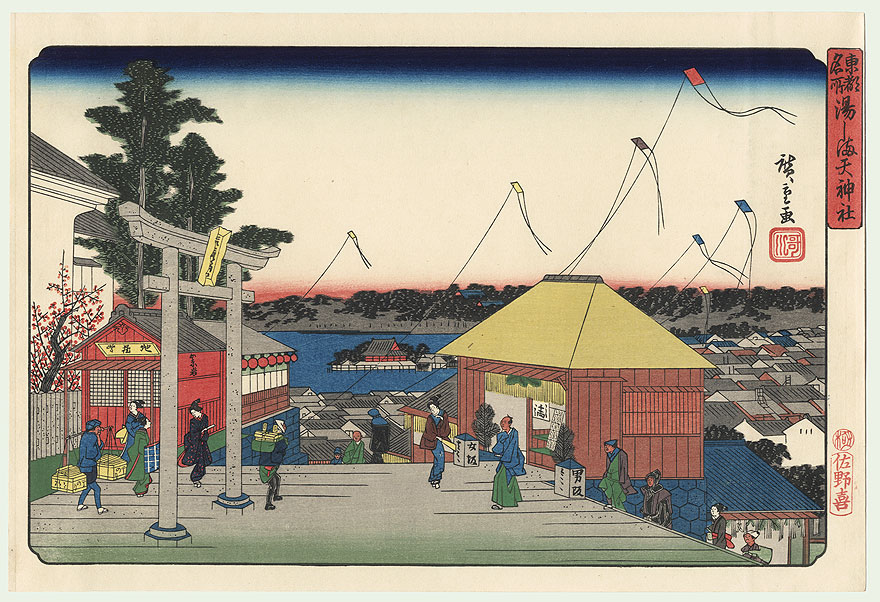| |
Hiroshige(1797 - 1858)Tenjin Shrine at Yushima
|
|

"Tenjin Shrine at Yushima"
(Yushima Tenjin yashiro 湯しま天神社)
Series: Famous Places in Edo "Kôto meisho" (江都名所)
(1918 Reprint)
Comment - Tenjin Shrine at Yushima -
Terrific hilltop view from Tenjin Shrine at Yushima, with a
stone torii gate at left and shops and restaurants lining the
street. This spot was famous for its view to the north and
east over the rooftops of Edo, with Shinobazu Pond in the
distances. Buildings are decorated for the New Year with
sacred straw or "shimenawa"
ropes hanging under the eaves and Kadomatsu pine branches
flanking the doorways. About seven Edo kites ("Edo-tako",
"江戸凧") fly overhead, their string tails fluttering in the
breeze, and a plum tree blooms at far left. The flowering plum
tree, showing the association with the Sugawara coat of arms,
with Sugarawa beeing one of the stakeholders of the shrine.
Yushima Tenman-gū Shrine (湯島天満宮) is a Shinto
shrine in Edo (nowadays Tokyo), devoted to Tenjin, the Kami of
Learning and Sugawara no Michizane, a scholar, poet, and
politician of the Heian Period to the court of Japan, and is
today revered in Shinto as the god of learning. It is a
frequent site of prospective students hoping to pass the
entrance exams.
Built in 458 for another kami, Ameno-tajikaraono-mikoto
(天手力雄命) of Japanese myth associated with strength and sports.
The shrine was expanded in 1355 to enshrine the kami Tenjin as
well. Currently both kami are enshrined at this temple. The
shrine was later rebuilt in 1455 at the behest of local
warlord Ota Dokan, and enjoyed greater popularity during the
Edo Period when it was visited by such Confucian scholars as
Hayashi Doshun and Arai Hakuseki.
Due to Tenjin's frequent association with plum trees, Yushima
Tenmangu maintains an extensive grove of plum trees, and holds
a yearly festival called ume matsuri (梅祭り) in February or
March depending on when the trees bloom.
Series - "Famous Places in Edo" (Koto Meisho or Toto Meisho, 江都名所). Another print with kites from the same series shows the "View of Kasumigaseki". More about HIROSHIGE's series are to be found here.
Edition - This woodblock is a 1918 reprint by Kawaoto. Compare with original of the second edition (1839 - 1842) called "Sanoki Half-Block Tokaido"
Artist - see Biography
Signature - "Hiroshige ga" (広重画) above the red
publisher's seal
Publisher - Kawaoto (川音), red seal, under signature (Reprint). The selvage of this reprint carries the original's censors seal (circular, Tanaka (田中) and the original publisher's seal of Sanoya Kihei (Kikakudô);
Image Size - 22.2 x 34.4 cm (8 3/4" x
13 1/2") + margins
Condition - single sheet; nishiki-e (cloured
woodblock); Horizontal ôban; Yoko-e ('landscape')
Copyright 2008 ff: Hans P. Boehme